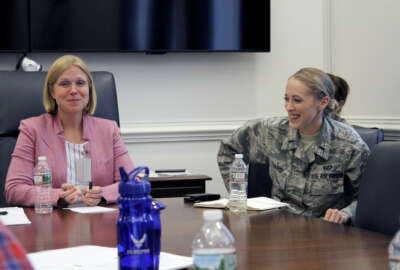
Air Force’s Knausenberger puts biggest obstacles to digital transformation in rearview mirror
Lauren Knausenberger, the outgoing chief information officer of the Air Force, said if requested funding for fiscal 2024 comes through as hoped for, several tra...
It’s not surprising that just a few years ago the Air Force’s two major challenges to technology modernization were people and budget, and not the technology itself.
When Lauren Knausenberger, the outgoing chief information officer of the Air Force, arrived in her role in 2020, she recognized the only way to get to the modern technology is to solve these two problems.

Knausenberger, whose last day on the job is June 2, said the Air Force not only overcame the budget and personnel obstacles, but is well on its way to digital transformation.
On the people side, Knausenberger said it was a matter of filling open positions and bringing some stability to the CIO role.
“There were budget cuts going on. IT was still the bill payer for things. It was not a ripe time to come in and just light the rocket and go,” Knausenberger said on Ask the CIO. “Really the first order of business was, how do I really rebuild this team? I’m pretty excited with the folks that are in those roles now, and the team is getting better and better and even more solid at that broader Air Force coalition.
Knausenberger said she hopes a new CIO will be hired and possibly in place before she leaves, but if that doesn’t happen, deputy CIO Winston Beauchamp would become acting CIO
“I think it’s great that we had a lot of people interested in the CIO position. I think it’s even better that we have a number of people internally that are highly qualified, that I know personally could get the job done. That makes me feel awesome, because the bench had gotten a little bit thin a few years ago. I think it’s awesome that we’ve been able to rebuild the bench over the past couple of years,” she said on Ask the CIO. “Then as far as external interest, I think that’s great, too. I do think it would be really hard for someone to come in with no Air Force experience or no Defense Department experience. But for the right person, then we’d surround them with the right people and get them going. But I think it is great that there are external candidates that are highly qualified, that are interested in serving, and have looked at myself and [former Navy CIO] Aaron Weiss and [former Army CIO] Raj Iyer over the last few years and said, ‘Hey, maybe this is something that I should do and maybe I should consider serving.’ We could get some stellar candidates that absolutely are right for this job. But because they applied for this job, maybe there are some other places where they can serve, and where they can really help us shake things up.”
Knausenbeger’s departure, announced in February, will mark the third service CIO to exit in the last five months with Iyer leaving in February and Weiss heading back to industry in March.
The timing of all three’s decisions aren’t related, but demonstrate the bigger challenge of being the CIO.
Next leg of the marathon
Knausenberger said part of the reason for her decision is family and the other part is the need for someone new to continue the marathon of digital transformation.
“We’ve done a lot of work to set up the funding, a very aggressive funding profile for fiscal 2024, and a really pretty fantastic set of plans. I do think that once those plans kick off, we’re going to need to have a CIO that can run no holds barred for the next two or three years. I know I don’t have that much in the tank. So I think this is a good time where I can do go do something good for me, and also hand it over to the next round of leaders who I have a lot of faith in and have them run,” she said. “This is something actually that Aaron Weiss and I discussed pretty shortly before we both announced that we would be departing. I feel very comfortable with the team that I have behind me, both in the CIO shop and in the broader Department of the Air Force. I feel very comfortable that I can walk out the door at this moment and have gotten some things done, but get to root even harder for the team.”
One of those things that she got done was changing the way the Air Force budgets for technology. That was a huge obstacle to digital transformation when she arrived in the role in 2020.
Knausenberger said not only did the Air Force not have money to upgrade or to modernize capabilities, but it was facing a $250 million shortfall at the end of each year.
She said without some “creative cash flowing” the Air Force wouldn’t have been able to pay its IT bills.
“One of the first goals that I set was a fiscal 2024 budget that works. It does take a couple of years to get there. The 2023 budget is way better than the 2022. We actually are fairly healthy in 2023 and we’ve been able to kick off some pretty solid progress around identity and access management, zero trust and continue to grow our cloud presence to solve problems across the enterprise,” Knausenberger said. “In 2024, that’s when we really have the right investments moving forward that will help us get out of some crushing technical debt. That will help us move forward to become much more cyber secure, much more resilient, to get better performance and to really be able to fight the way that we should in a digital environment. A lot of that investment kicks off in 2024. If it comes through the way that it is expected to, it will be pretty sizable and the team is raring to go. There is a lot of planning, lot of testing concept of operations, but folks are pretty excited about that investment.”
Budget shortfalls hurt EITaaS
The funding shortfalls happened for several reasons, including spending money on too many licenses for software or paying too much for Office 365 licenses.
She said the Air Force failed to shut down old communications technologies.
“There were things that we had to stop doing, and unfortunately, that means that those transformation programs did not go forward as fast as we wanted them to or have stopped. We had to make tough decisions in places, and we did,” Knausenberger said. “There were places also that we could save a lot of money. We renegotiated a number of enterprise software deals, where we saved very large amounts of money. This year, we renegotiated some of our Office 365 licenses and that actually took care of a lot of our under use going into the year. There are places where we had to get smarter with negotiations, and then there were places where we had to cut. There were places where we just had to find the money.”
She said the budget shortfalls impacted several programs including the enterprise IT-as-a-service (EITaaS) risk reduction effort, meaning the Air Force couldn’t go to as many bases as it wanted to test out the concepts. Another project called compute and storage-as-a-service also felt the pinch of the budget shortfalls as did the modern approach the service tested out for security operations center-as-a-service.
If Congress comes through with the funding the Air Force requested for IT and cybersecurity in 2024 — roughly $10.2 billion — Knausenberger said the impact across the entire service will be immediate. That request is less than what the Air Force asked for in 2022, $11.2 billion.
“We have fully funded our cloud accounts, which means that we can migrate applications at a faster rate into the cloud. We’ve already done the really hard work of fixing anything that we could do with process and partnership,” she said. “As far as the SOC, I see some really good progress there. Now that will jumpstart in 2024 as we’ll have a procurement out on that. Then EITaaS Wave One is our scaling function for the endpoints, the IT store, the central IT service management, just so many of the 1,000 paper cuts that just get everybody every day are holding on into EITaaS Wave One.”
Additionally, the 2024 funding will let Air Force expand EITaaS with an award for Wave Two for base infrastructure modernization.
In addition to Wave Two, the funding will help the Air Force move to the next generation network infrastructure that includes software-defined networking, which also is part of the service’s zero trust architecture and framework.
Knausenberger said whoever the next CIO is, that person will have the budget, the people, the plans and the technology in place to scale and transform much of the Air Force’s capabilities.
“We’re on a really great trajectory to not have all of the silly little things that have caused problems over the last decade or two continue to cause the same problems for the next decade. I think that I think we have irreversible momentum,” she said. “If the next CIO comes in and continues to work the plan that was signed, not just by me, but by our Air Force and Space Force counterparts, and really, really taken on by our lead commanders and our lead PEOs, then I think that’s going to be a good thing. If the next CIO sees places where maybe we missed something, that’s a great place to add. But I think within the core team, we looked at even beyond me, moving on, it’s the right plan, and the community has bought in on the plan, and we just need to deliver.”
Copyright © 2024 Federal News Network. All rights reserved. This website is not intended for users located within the European Economic Area.
Jason Miller is executive editor of Federal News Network and directs news coverage on the people, policy and programs of the federal government.
Follow @jmillerWFED






